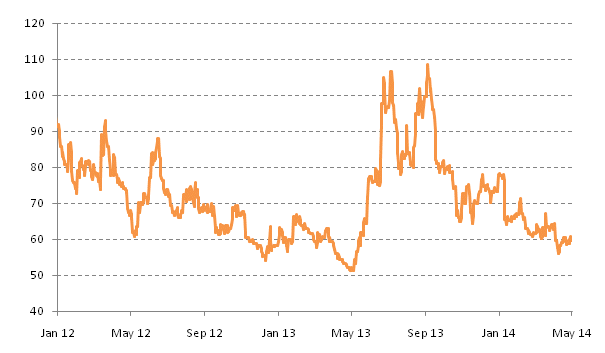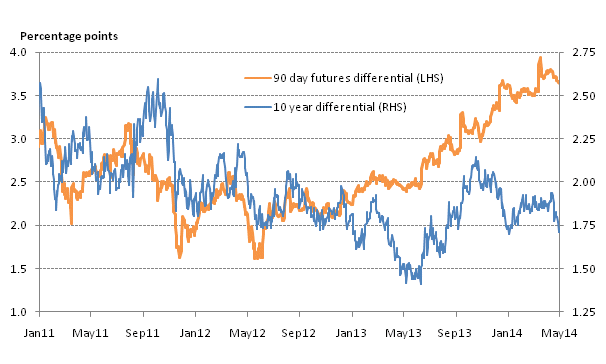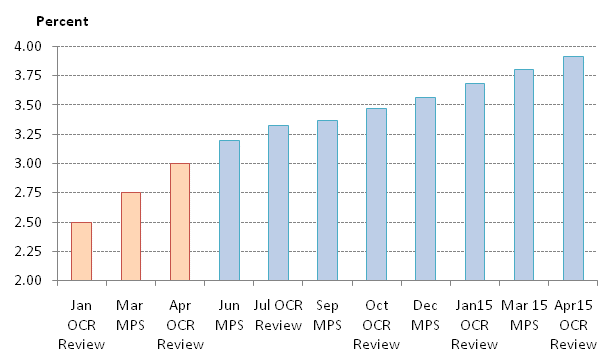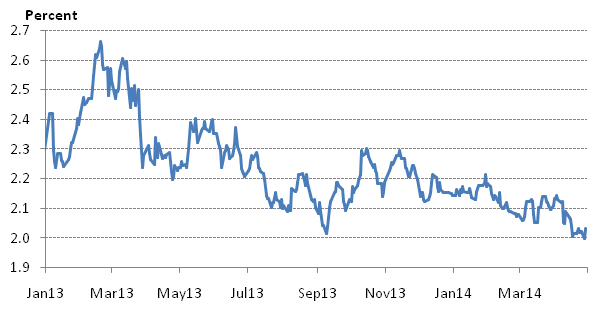Low volatility feeds a search for yield
Sunday, May 11th 2014, 1:37PM
by Harbour Asset Management
| The RBNZ delivered another 25 bpt increase to OCR |
| The 2 year swp rate remains in a narrow 4.00-4.10% range |
| Global bond markets have also been remarkably stable. Implied volatilities from US treasury bond option contracts have fallen to their lowest since mid-2013 |
| This low volatility has encouraged a search for yield globally. Over the course of April, this was most evident in the NZ 10 year government bond, where global demand saw yields squeezed 20 basis points lower without reinforcing economic news |
| Over the medium term, we continue to see the risks skewed towards higher yields as the global economy recovers, removing the need for to such exceptional monetary policy support |
| One key local event approaching in May is the NZ Budget, where a lower composition of new bond issuance in inflation linked bonds may create an opportunity for inflation breakevens to re-price higher. |
| The announcement of Labour’s monetary policy proposals had little immediate impact on the market. |
For all the media commentary this year on sources of market volatility – emerging market crises, Ukrainian conflict, and tech stock shake outs – in fixed interest markets things have been remarkably stable.
The US economic data were a little weaker than expected at the beginning of the year, but since then US economic outturns have been pretty solid – PMIs comfortably above 50, and monthly payrolls averaging a healthy 200k per month. This has kept the US Fed on track with its plan to steadily taper its Quantitative Easing purchases in a way that creates the least policy uncertainty. In April its decision to taper almost went unnoticed by the mainstream media.
In the stable macroeconomic and policy environment, the US 10 year government bond yield has traded in a very tight 2.60-2.75% range for much of the year, ending April near the lower end. Implied volatility from US treasury bond option contracts have fallen to their lowest levels since mid 2013 (Chart 1).
Chart 1: Implied volatility from US treasury options

Source: Merrill Lynch and Bloomberg.
Low volatility and steep yield curves feeds a search for yield
This low volatility has driven a search for yield in fixed interest markets.
As always in this type of environment, global investors have favoured investing into corporate bond markets where there is additional credit premium to be picked up, and countries where there is a steep yield curve and additional duration premium on offer.
Over the course of April, this search for yield has been most evident in the NZ 10 year government bond, where this global demand saw yields squeezed lower without any reinforcing economic news. As a result, the NZ-US 10 year bond spread contracted, despite being in an environment where the RBNZ is tightening local monetary policy which would normally see those spreads widen (Chart 2). The NZ 10 year government bond yield ended the month about 20 basis points lower at 4.40%.
Chart 2: NZ-US yield spreads

Source: Bloomberg.
Search for yield vs the normalisation of yields
While the search for yield saw NZ yields squeeze lower in April, we continue to believe the risks are skewed towards higher future yields, from 2 main sources:
- At the short end of the yield curve, we see scope for the RBNZ to continue on its hiking cycle. As widely expected, the RBNZ lifted the OCR again in April to 3.00%. With business and consumer confidence holding up, and banks competing strongly for mortgage business, we would not rule out the possibility of consecutive increases at the RBNZ’s June and July meetings (Chart 3). Key things to watch are the path of the exchange rate and the next CPI outturn in mid July.
- At the long end of the yield curve, even if the US economic data is not spectacular, with further solid data and the passage of time to heal the economy, the US Fed will have to modify its communications and ready the market for upcoming increases in the US Fed Funds Rate. It was this sort of change in communication that knocked the market out of its period of low volatility in mid 2013 when Bernanke gave the first hint of the Fed considering QE tapering.
Chart 3: Overnight Indexed Swaps

Source: Bloomberg.
NZ budget
Looking into May, one of the key events for the NZ fixed interest market will be the NZ Budget. Bill English has already flagged that New Zealand is likely to have a small surplus in 2014/15. What we will be looking more closely for is the composition of NZ government bond issuance.
Over the course of 2013/14, a major theme has been the NZ government seeking to get some critical mass in the size of the NZ inflation linked market. With a rough target of bringing inflation linked bonds up to around 20% of NZ government bonds outstanding, during 2013/14 new issuance has been heavily skewed to inflation linked bonds. However, as they quickly approach this target level of inflation linked bond outstanding, they should be able to revert back to a more balanced new issuance program.
That type of approach may take pressure off the NZ inflation linked market that has struggled to absorb issuance in 2013/14. That weight of supply helped push so-called inflation breakevens (the different between nominal and real yields) down to 2% in an environment where NZ’s future inflation pressures have been rising not falling (Chart 4). We continue to believe that NZ inflation linked bonds provide good value for investors seeking protection against future inflation risks.
Chart 4: NZ inflation breakevens (2025s)

Source: Bloomberg and Harbour Asset Management calculations.
Labour Party monetary policy proposals
Finally, in other developments for the fixed interest market, the Labour Party (Labour) announced it monetary policy proposals, identifying New Zealand’s persistent current account deficits as a problem that needs to be addressed.
At the heart of their monetary policy proposal is the idea that the RBNZ should shoulder the responsibility for this problem, and that KiwiSaver should be used as a policy tool to address it. However, making the RBNZ responsible for external balances blurs the lines between monetary policy and fiscal policy; and using KiwiSaver as a cyclical policy tool seriously risks undermining its role as a long-term saving scheme. A cleaner alternative approach would be to make the Government itself responsible and accountable for the external balance. Even then, it is a difficult policy goal to deliver and would require patience.
The good news is that Labour have kept the RBNZ’s independence and inflation target at the heart of their proposal. This element was widely welcomed, and (along with Labour’s lower polling) explains why the Labour’s proposal did not scare the market.
Christian Hawkesby
Director, Head of Fixed Interest & Economics
Harbour Asset Management
Important disclaimer information
| « New Zealand's big bet on China | Ditching fossil fuels will pay off: Fund manager » |
Special Offers
Comments from our readers
No comments yet
Sign In to add your comment
| Printable version | Email to a friend |









